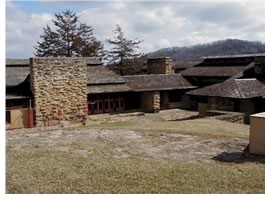
Taliesin, the expansive 600 acres that envelopes Frank Lloyd Wright's home, studio, and architecture school in Spring Green, Wisc., continues to surrender to the natural landscape that has shaped the architectural masterpiece's beauty and significance. The hill into which Taliesin nestles is shifting, causing extensive damage to its walls, walkways, and patios.
 James
E. Goulka, president and CEO of the Frank Lloyd Wright Foundation, which
owns the house, school, and for-profit architecture firm on the site,
told the Associated Press and
the Milwaukee Journal-Sentinel
that workers are starting a $900,000 project that they hope will stabilize
the hill on which Taliesin stands, rebuilding a collapsed maintenance
tunnel that caused stone walkways to sink and crack, and installing a
system of pipes that will prevent water from building up in the hillside.
A $1 million matching grant from the National Park Service's Save America's
Treasures program will help pay for new drainage at the site. Preservationists
will then work to shore up the property's foundation and its formal living
room, bedrooms, and guest wing. These repairs are part of an ongoing restoration
project, Goulka told the Sentinel.
Hundreds of other spaces at Taliesin also await conservation and rejuvenation.
Goulka said the repairs may ultimately cost $60 million.
James
E. Goulka, president and CEO of the Frank Lloyd Wright Foundation, which
owns the house, school, and for-profit architecture firm on the site,
told the Associated Press and
the Milwaukee Journal-Sentinel
that workers are starting a $900,000 project that they hope will stabilize
the hill on which Taliesin stands, rebuilding a collapsed maintenance
tunnel that caused stone walkways to sink and crack, and installing a
system of pipes that will prevent water from building up in the hillside.
A $1 million matching grant from the National Park Service's Save America's
Treasures program will help pay for new drainage at the site. Preservationists
will then work to shore up the property's foundation and its formal living
room, bedrooms, and guest wing. These repairs are part of an ongoing restoration
project, Goulka told the Sentinel.
Hundreds of other spaces at Taliesin also await conservation and rejuvenation.
Goulka said the repairs may ultimately cost $60 million.
Noting the historic importance of Taliesin, Goulka told the Sentinel he hopes that the grounds of the estate can be restored to how they were when Wright was active in the 1950s. "This is the place for Wright," Goulka told the Sentinel. "It's the center of his creativity, the practice palette for everything he did elsewhere. So it's an extraordinarily important place to preserve." The site is also home to six major Wright-designed buildings on the property. The buildings now serve as the home for Wright's surviving apprentices, an accredited architecture school, a prototype for the artist's residence and studio, and a working for-profit architecture firm.
The NPS designated Taliesin a National Landmark in 1976. The agency has also since listed it as a "Priority 1" threatened landmark. Taliesin has weathered its share of woes in its 90 years. It was set afire in 1914 and again in 1925. Later, it was the focus of creditors and tax collectors. More recently, in 1998, powerful winds blew a large, 225-year-old oak onto the roof of the studio wing of the main building. The roof was later rebuilt.
The Taliesin renovation comes on the heels of the restoration of another Wright masterpiece, Fallingwater in Pittsburgh, which required major structural repairs, restoration of the wood furniture and steel sash, waterproofing, and installation of a zero-discharge waste management system.
Copyright 2002 The American Institute of Architects. All rights reserved.
![]()
|
Read about renovations to Wright's Fallingwater. Click here for information on Taliesin from the Frank Lloyd Wright Foundation. |
|